Optimization of Components with Topology Optimization for Direct Additive Manufacturing by DLMS
Abstract
1. Introduction
Current Solution of Case Study
2. Optimization of the Steering Column Housing
2.1. Material
2.2. Design Area of Optimization
2.3. Parameters of Topology Optimization
2.4. Specification of Input Load Cases
3. Verification Analysis of the Result of TO
3.1. Generation of FE Mesh from STL Model
3.2. Verification Using Independent Structural Analysis
4. Functional Specimen
4.1. Pre-Processing of Functional Specimen Manufacturability
4.2. Numerical Simulation of Printing Process
4.3. Fabrication of Functional Specimen
5. Discussion
6. Conclusions
Author Contributions
Funding
Institutional Review Board Statement
Informed Consent Statement
Data Availability Statement
Acknowledgments
Conflicts of Interest
References
- Cao, B.; Zhao, J.; Yang, P.; Gu, Y.; Muhammad, K.; Rodrigues, J.J.P.C.; De Albuquerque, V.H.C. Multiobjective 3-D Topology Optimization of Next-Generation Wireless Data Center Network. IEEE Trans. Ind. Inf. 2020, 16, 3597–3605. [Google Scholar] [CrossRef]
- Galilei, G.; Elzevir, B.; Elzevir, A. Discorsi e Dimostrazioni Matematiche Intorno à Due Nuoue Scienze, Attenenti Alla Mecanica & i Movimenti Locali; Elsevier: Leida, The Netherlands, 1638; ISBN 978-1-4832-8527-6. [Google Scholar]
- Michell, A.G.M. LVIII. The Limits of Economy of Material in Frame-Structures. Lond. Edinb. Dublin Philos. Mag. J. Sci. 1904, 8, 589–597. [Google Scholar] [CrossRef]
- Raz, K.; Hora, J.; Pavlata, P. Unconventional Materials Usage in Design of Vehicle Bodies. Manuf. Technol. 2017, 17, 823–827. [Google Scholar] [CrossRef]
- Rao, S.S. Engineering Optimization: Theory and Practice, 4th ed.; Wiley: Hoboken, NJ, USA, 2009; ISBN 978-0-470-18352-6. [Google Scholar]
- Goncharov, P. Engineering Analysis with NX Advanced Simulation; Lulu Press: Raleigh, NC, USA, 2014. [Google Scholar]
- Kim, H.-G.; Nerse, C.; Wang, S. Topography Optimization of an Enclosure Panel for Low-Frequency Noise and Vibration Reduction Using the Equivalent Radiated Power Approach. Mater. Des. 2019, 183, 108125. [Google Scholar] [CrossRef]
- Papadrakakis, M.; Tsompanakis, Y.; Hinton, E.; Sienz, J. Advanced Solution Methods in Topology Optimization and Shape Sensitivity Analysis. Eng. Comput. 1996, 13, 57–90. [Google Scholar] [CrossRef]
- Xiao, Z.; Yang, Y.; Wang, D.; Song, C.; Bai, Y. Structural Optimization Design for Antenna Bracket Manufactured by Selective Laser Melting. Rapid Prototyp. J. 2018, 24, 539–547. [Google Scholar] [CrossRef]
- Bendsoe, M.P.; Sigmund, O. Topology Optimization: Theory, Methods, and Applications, 2nd ed.; Springer: Berlin/Heidelberg, Germany, 2004; ISBN 978-3-540-42992-0. [Google Scholar]
- Prager, W.; Rozvany, G.I.N. Optimization of Structural Geometry. In Dynamical Systems; Bednarek, A.R., Cesari, L., Eds.; Academic Press: Cambridge, MA, USA, 1977; pp. 265–293. ISBN 978-0-12-083750-2. [Google Scholar]
- Tang, Y.; Zhao, Y.F. A Survey of the Design Methods for Additive Manufacturing to Improve Functional Performance. Rapid Prototyp. J. 2016, 22, 569–590. [Google Scholar] [CrossRef]
- Rozvany, G.I.N. A Critical Review of Established Methods of Structural Topology Optimization. Struct. Multidisc. Optim. 2009, 37, 217–237. [Google Scholar] [CrossRef]
- Bendsøe, M.P.; Sigmund, O. Material Interpolation Schemes in Topology Optimization. Arch. Appl. Mech. (Ing. Arch.) 1999, 69, 635–654. [Google Scholar] [CrossRef]
- Bendsøe, M.P. Optimal Shape Design as a Material Distribution Problem. Struct. Optim. 1989, 1, 193–202. [Google Scholar] [CrossRef]
- Zhou, M.; Rozvany, G.I.N. The COC Algorithm, Part II: Topological, Geometrical and Generalized Shape Optimization. Comput. Methods Appl. Mech. Eng. 1991, 89, 309–336. [Google Scholar] [CrossRef]
- Stolpe, M.; Svanberg, K. An Alternative Interpolation Scheme for Minimum Compliance Topology Optimization. Struct. Multidiscip. Optim. 2001, 22, 116–124. [Google Scholar] [CrossRef]
- Allaire, G. The Homogenization Method for Topology and Shape Optimization. In Topology Optimization in Structural Mechanics; Springer: Vienna, Austria, 1997; pp. 101–133. [Google Scholar]
- Beckers, M.; Fleury, C. Topology Optimization Involving Discrete Variables. In Proceedings of the Second World Congress of Structural and Multidisciplinary Optimization, Zakopane, Poland, 26–30 May 1997; Polish Academy of Sciences, Institute of Fundamental Technological Research: Warszawa, Poland, 1997; pp. 533–538. [Google Scholar]
- Xie, Y.M.; Huang, X. Recent Developments in Evolutionary Structural Optimization (ESO) for Continuum Structures. In Proceedings of the IOP Conference Series: Materials Science and Engineering; IOP Publishing: Bristol, UK, 2010; Volume 10, p. 012196. [Google Scholar]
- Querin, O.M.; Young, V.; Steven, G.P.; Xie, Y.M. Computational Efficiency and Validation of Bi-Directional Evolutionary Structural Optimisation. Comput. Methods Appl. Mech. Eng. 2000, 189, 559–573. [Google Scholar] [CrossRef]
- Querin, O.M.; Steven, G.P.; Xie, Y.M. Evolutionary Structural Optimisation Using an Additive Algorithm. Finite Elem. Anal. Des. 2000, 34, 291–308. [Google Scholar] [CrossRef]
- ASTM F2792-12a; Terminology for Additive Manufacturing Technologies. ASTM International: West Conshohocken, PA, USA, 2012.
- Bull, G.; Haj-Hariri, H.; Atkins, R.; Moran, P. An Educational Framework for Digital Manufacturing in Schools. 3D Print. Addit. Manuf. 2015, 2, 42–49. [Google Scholar] [CrossRef]
- Scott, A.; Harrison, T.P. Additive Manufacturing in an End-to-End Supply Chain Setting. 3D Print. Addit. Manuf. 2015, 2, 65–77. [Google Scholar] [CrossRef]
- Seepersad, C.C. Challenges and Opportunities in Design for Additive Manufacturing. 3D Print. Addit. Manuf. 2014, 1, 10–13. [Google Scholar] [CrossRef]
- Gordon, R. Trends in Commercial 3D Printing and Additive Manufacturing. 3D Print. Addit. Manuf. 2015, 2, 89–90. [Google Scholar] [CrossRef]
- Hosny, A.; Keating, S.J.; Dilley, J.D.; Ripley, B.; Kelil, T.; Pieper, S.; Kolb, D.; Bader, C.; Pobloth, A.-M.; Griffin, M.; et al. From Improved Diagnostics to Presurgical Planning: High-Resolution Functionally Graded Multimaterial 3D Printing of Biomedical Tomographic Data Sets. 3D Print. Addit. Manuf. 2018, 5, 103–113. [Google Scholar] [CrossRef]
- ISO 17296:2015; Additive Manufacturing—General Principles—Part 2: Overview of Process Categories and Feedstock. ISO: Geneva, Switzerland, 2015.
- ISO/ASTM 52901:2017; Additive Manufacturing—General Principles—Requirements for Purchased AM Parts. ISO: Geneva, Switzerland, 2017.
- Barnatt, C. 3D Printing: Third Edition; CreateSpace Independent Publishing Platform: Scotts Valey, CA, USA, 2016; ISBN 978-1-5396-5546-6. [Google Scholar]
- ISO/ASTM 52915:2013; Standard Specification for Additive Manufacturing File Format. ISO: Geneva, Switzerland, 2013.
- ISO/ASTM 52900-15; Standard Terminology for Additive Manufacturing–General Principles–Terminology. ASTM International: West Conshohocken, PA, USA, 2015.
- Chia, H.N.; Wu, B.M. Recent Advances in 3D Printing of Biomaterials. J. Biol. Eng. 2015, 9, 4. [Google Scholar] [CrossRef]
- Snyder, T.J.; Andrews, M.; Weislogel, M.; Moeck, P.; Stone-Sundberg, J.; Birkes, D.; Hoffert, M.P.; Lindeman, A.; Morrill, J.; Fercak, O.; et al. 3D Systems’ Technology Overview and New Applications in Manufacturing, Engineering, Science, and Education. 3D Print. Addit. Manuf. 2014, 1, 169–176. [Google Scholar] [CrossRef]
- Dul, S.; Fambri, L.; Pegoretti, A. Fused Deposition Modelling with ABS–Graphene Nanocomposites. Compos. Part A Appl. Sci. Manuf. 2016, 85, 181–191. [Google Scholar] [CrossRef]
- Chacón, J.M.; Caminero, M.A.; García-Plaza, E.; Núñez, P.J. Additive Manufacturing of PLA Structures Using Fused Deposition Modelling: Effect of Process Parameters on Mechanical Properties and Their Optimal Selection. Mater. Des. 2017, 124, 143–157. [Google Scholar] [CrossRef]
- Chua, C.K.; Leong, K.F. 3D Printing and Additive Manufacturing: Principles and Applications (with Companion Media Pack) Fourth Edition of Rapid Prototyping, 4th ed.; World Scientific Publishing Company: Singapore, 2014; ISBN 978-981-4578-49-3. [Google Scholar]
- Quetzeri-Santiago, M.A.; Hedegaard, C.L.; Castrejón-Pita, J.R. Additive Manufacturing with Liquid Latex and Recycled End-of-Life Rubber. 3D Print. Addit. Manuf. 2019, 6, 149–157. [Google Scholar] [CrossRef]
- Miyanaji, H.; Zhang, S.; Lassell, A.; Zandinejad, A.; Yang, L. Process Development of Porcelain Ceramic Material with Binder Jetting Process for Dental Applications. JOM 2016, 68, 831–841. [Google Scholar] [CrossRef]
- Zhou, Y.; Tang, Y.; Hoff, T.; Garon, M.; Zhao, F.Y. The Verification of the Mechanical Properties of Binder Jetting Manufactured Parts by Instrumented Indentation Testing. Procedia Manuf. 2015, 1, 327–342. [Google Scholar] [CrossRef]
- Mani, M.; Feng, S.; Lane, B.; Donmez, A.; Moylan, S.; Fesperman, R. Measurement Science Needs for Real-Time Control of Additive Manufacturing Powder Bed Fusion Processes; US Department of Commerce, National Institute of Standards and Technology: Gaithersburg, MD, USA, 2015. [Google Scholar]
- Chen, L.Y.; Huang, J.C.; Lin, C.H.; Pan, C.T.; Chen, S.Y.; Yang, T.L.; Lin, D.Y.; Lin, H.K.; Jang, J.S.C. Anisotropic Response of Ti-6Al-4V Alloy Fabricated by 3D Printing Selective Laser Melting. Mater. Sci. Eng. A 2017, 682, 389–395. [Google Scholar] [CrossRef]
- Brandt, M. (Ed.) Laser Additive Manufacturing: Materials, Design, Technologies, and Applications; Woodhead Publishing Series in Electronic and Optical Materials; Elsevier/Woodhead Publishing: Boston, MA, USA, 2017; ISBN 978-0-08-100433-3. [Google Scholar]
- Sutton, A.T.; Kriewall, C.S.; Leu, M.C.; Newkirk, J.W. Powder Characterisation Techniques and Effects of Powder Characteristics on Part Properties in Powder-Bed Fusion Processes. Virtual Phys. Prototyp. 2017, 12, 3–29. [Google Scholar] [CrossRef]
- Heigel, J.C.; Michaleris, P.; Reutzel, E.W. Thermo-Mechanical Model Development and Validation of Directed Energy Deposition Additive Manufacturing of Ti–6Al–4V. Addit. Manuf. 2015, 5, 9–19. [Google Scholar] [CrossRef]
- Ahmed, N. Direct Metal Fabrication in Rapid Prototyping: A Review. J. Manuf. Process. 2019, 42, 167–191. [Google Scholar] [CrossRef]
- ISO/ASTM 52900:2015; Additive Manufacturing—General Principles—Terminology. ISO: Geneva, Switzerland, 2015.
- Rokicki, P.; Kozik, B.; Budzik, G.; Dziubek, T.; Bernaczek, J.; Przeszlowski, L.; Markowska, O.; Sobolewski, B.; Rzucidlo, A. Manufacturing of Aircraft Engine Transmission Gear with SLS (DMLS) Method. Aircr. Eng. Aerosp. Technol. Int. J. 2016, 88, 397–403. [Google Scholar] [CrossRef]
- Rahmati, S. Direct Rapid Tooling. In Comprehensive Materials Processing; Elsevier: Amsterdam, The Netherlands, 2014; pp. 303–344. ISBN 978-0-08-096533-8. [Google Scholar]
- Korkmaz, M.E.; Gupta, M.K.; Robak, G.; Moj, K.; Krolczyk, G.M.; Kuntoğlu, M. Development of Lattice Structure with Selective Laser Melting Process: A State of the Art on Properties, Future Trends and Challenges. J. Manuf. Process. 2022, 81, 1040–1063. [Google Scholar] [CrossRef]
- Prathyusha, A.L.R.; Raghu Babu, G. A Review on Additive Manufacturing and Topology Optimization Process for Weight Reduction Studies in Various Industrial Applications. Mater. Today Proc. 2022, 62, 109–117. [Google Scholar] [CrossRef]
- Prathyusha, A.; Babu, G.R. 3D Printing Integration with Topology Optimization for Innovative Design and Fabrication of Light Weight Aerospace Structures. In Proceedings of the 2022 International Conference on Recent Trends in Microelectronics, Automation, Computing and Communications Systems (ICMACC), Hyderabad, India, 28–30 December 2022; IEEE: Piscataway, NJ, USA, 2022; pp. 1–6. [Google Scholar]
- Dienemann, R.; Schewe, F.; Elham, A. Industrial Application of Topology Optimization for Forced Convection Based on Darcy Flow. Struct. Multidisc. Optim. 2022, 65, 265. [Google Scholar] [CrossRef]
- Barbieri, L.; Muzzupappa, M. Performance-Driven Engineering Design Approaches Based on Generative Design and Topology Optimization Tools: A Comparative Study. Appl. Sci. 2022, 12, 2106. [Google Scholar] [CrossRef]
- Kim, J.; Park, J.H.; Jang, S.; Jeong, H.; Kim, T.; Kim, H.G. Effect of Support Structures on the Deformation of AlSi10Mg Aircraft Parts Made Using DMLS. Int. J. Precis. Eng. Manuf. 2023, 24, 837–851. [Google Scholar] [CrossRef]
- Bouabbou, A.; Vaudreuil, S. Understanding Laser-Metal Interaction in Selective Laser Melting Additive Manufacturing through Numerical Modelling and Simulation: A Review. Virtual Phys. Prototyp. 2022, 17, 543–562. [Google Scholar] [CrossRef]
- Azami, M.; Siahsarani, A.; Hadian, A.; Kazemi, Z.; Rahmatabadi, D.; Kashani-Bozorg, S.F.; Abrinia, K. Laser Powder Bed Fusion of Alumina/Fe–Ni Ceramic Matrix Particulate Composites Impregnated with a Polymeric Resin. J. Mater. Res. Technol. 2023, 24, 3133–3144. [Google Scholar] [CrossRef]
- Ghasri-Khouzani, M.; Peng, H.; Attardo, R.; Ostiguy, P.; Neidig, J.; Billo, R.; Hoelzle, D.; Shankar, M.R. Comparing Microstructure and Hardness of Direct Metal Laser Sintered AlSi10Mg Alloy between Different Planes. J. Manuf. Process. 2019, 37, 274–280. [Google Scholar] [CrossRef]
- Krishnan, M.; Atzeni, E.; Canali, R.; Calignano, F.; Manfredi, D.; Ambrosio, E.P.; Iuliano, L. On the Effect of Process Parameters on Properties of AlSi10Mg Parts Produced by DMLS. Rapid Prototyp. J. 2014, 20, 449–458. [Google Scholar] [CrossRef]
- Montanari, R.; Palombi, A.; Richetta, M.; Varone, A. Additive Manufacturing of Aluminum Alloys for Aeronautic Applications: Advantages and Problems. Metals 2023, 13, 716. [Google Scholar] [CrossRef]
- ASTM E8/E8M-16a; Standard Test Methods for Tension Testing of Metallic Materials. ASTM International: West Conshohocken, PA, USA, 2016.
- Alsalla, H.H.; Smith, C.; Hao, L. The Effect of Different Build Orientations on the Consolidation, Tensile and Fracture Toughness Properties of Direct Metal Laser Sintering Ti-6Al-4V. Rapid Prototyp. J. 2018, 24, 276–284. [Google Scholar] [CrossRef]
- Promoppatum, P.; Yao, S.-C. Influence of Scanning Length and Energy Input on Residual Stress Reduction in Metal Additive Manufacturing: Numerical and Experimental Studies. J. Manuf. Process. 2020, 49, 247–259. [Google Scholar] [CrossRef]
- Špirk, S.; Špička, J.; Vychytil, J.; Křížek, M.; Stehlík, A. Utilization of the Validated Windshield Material Model in Simulation of Tram to Pedestrian Collision. Materials 2021, 14, 265. [Google Scholar] [CrossRef]
- Rypl, D.; Bittnar, Z. Generation of Computational Surface Meshes of STL Models. J. Comput. Appl. Math. 2006, 192, 148–151. [Google Scholar] [CrossRef]
- Zienkiewicz, O.C.; Taylor, R.L.; Zhu, J.Z. The Finite Element Method: Its Basis and Fundamentals, 7th ed.; Butterworth-Heinemann: Amsterdam, The Netherlands, 2013; ISBN 978-1-85617-633-0. [Google Scholar]
- Liu, Y.; Li, Z.; Wei, P.; Chen, S. Generating Support Structures for Additive Manufacturing with Continuum Topology Optimization Methods. Rapid Prototyp. J. 2018, 25, 232–246. [Google Scholar] [CrossRef]
- Jiang, J.; Stringer, J.; Xu, X. Support Optimization for Flat Features via Path Planning in Additive Manufacturing. 3D Print. Addit. Manuf. 2019, 6, 171–179. [Google Scholar] [CrossRef]
- Hildreth, O.J.; Nassar, A.R.; Chasse, K.R.; Simpson, T.W. Dissolvable Metal Supports for 3D Direct Metal Printing. 3D Print. Addit. Manuf. 2016, 3, 90–97. [Google Scholar] [CrossRef]
- Lefky, C.S.; Zucker, B.; Wright, D.; Nassar, A.R.; Simpson, T.W.; Hildreth, O.J. Dissolvable Supports in Powder Bed Fusion-Printed Stainless Steel. 3D Print. Addit. Manuf. 2017, 4, 3–11. [Google Scholar] [CrossRef]
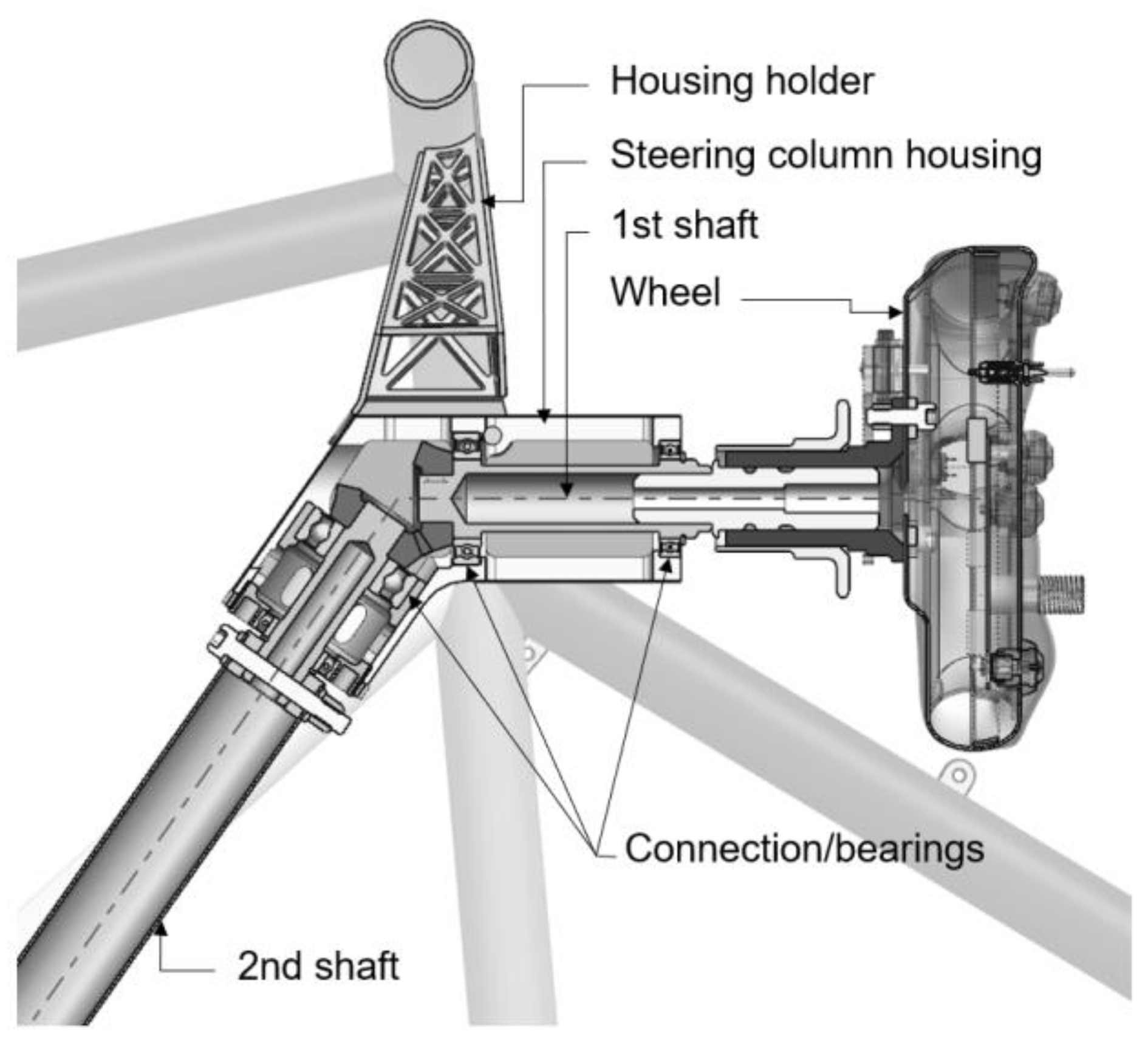
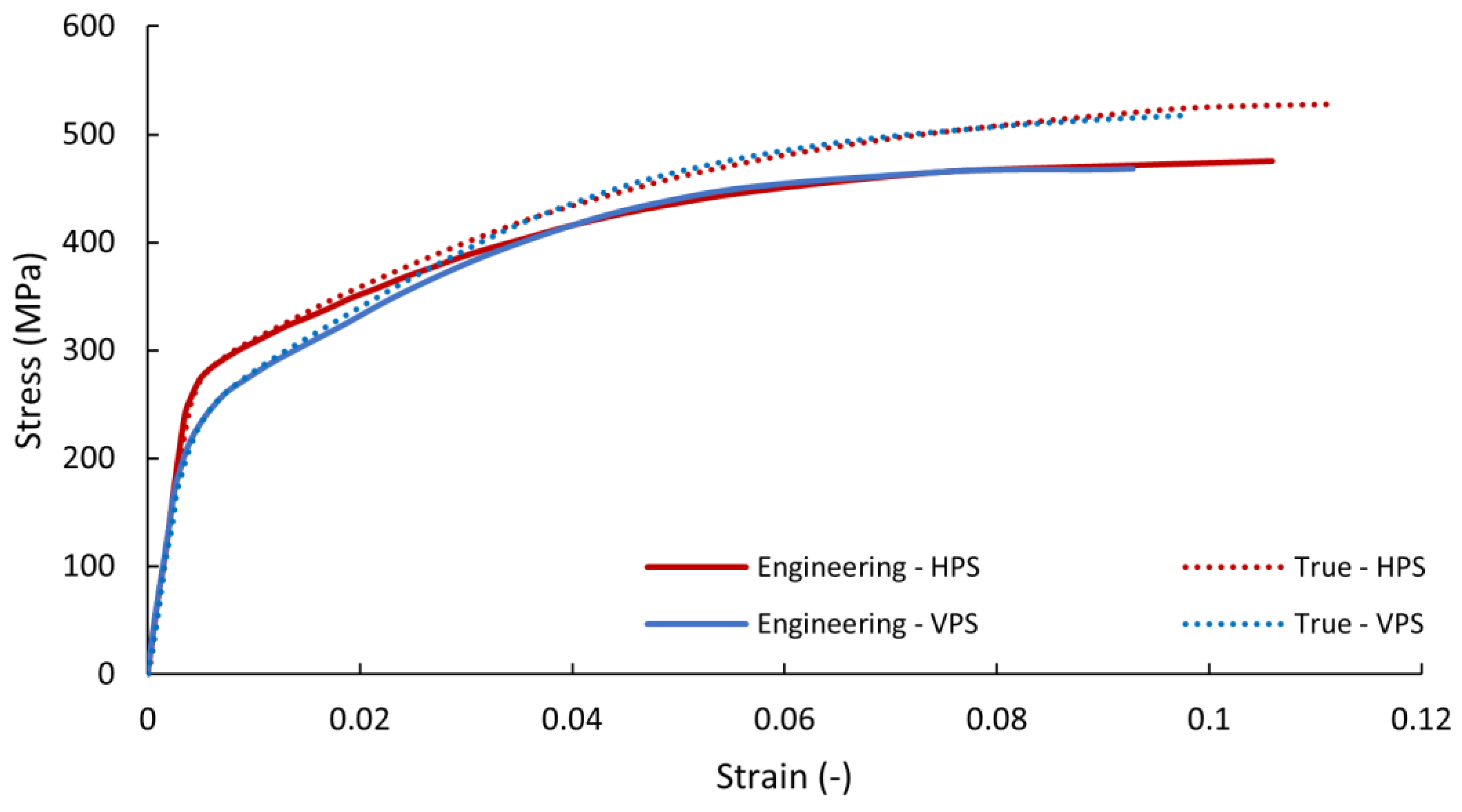
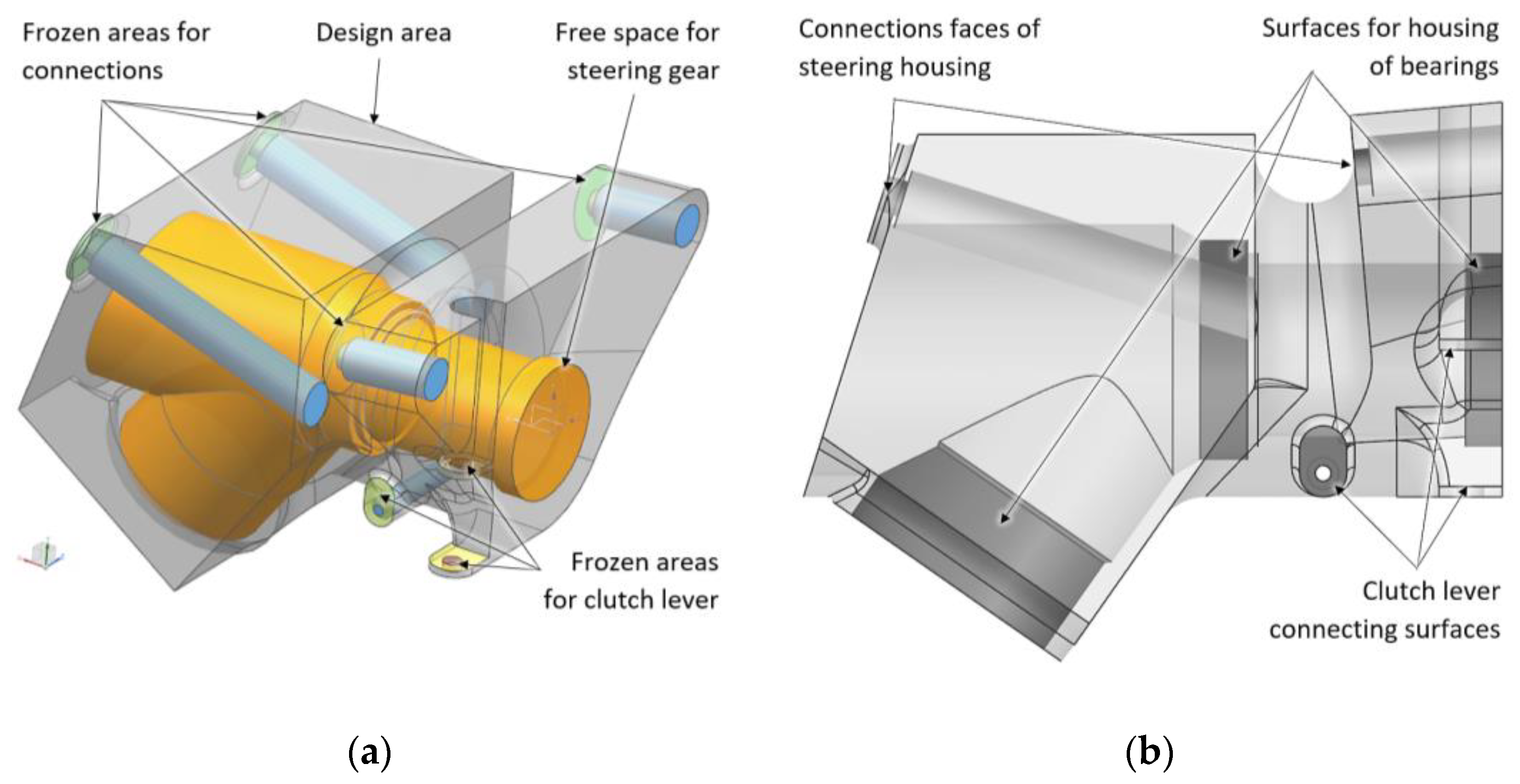

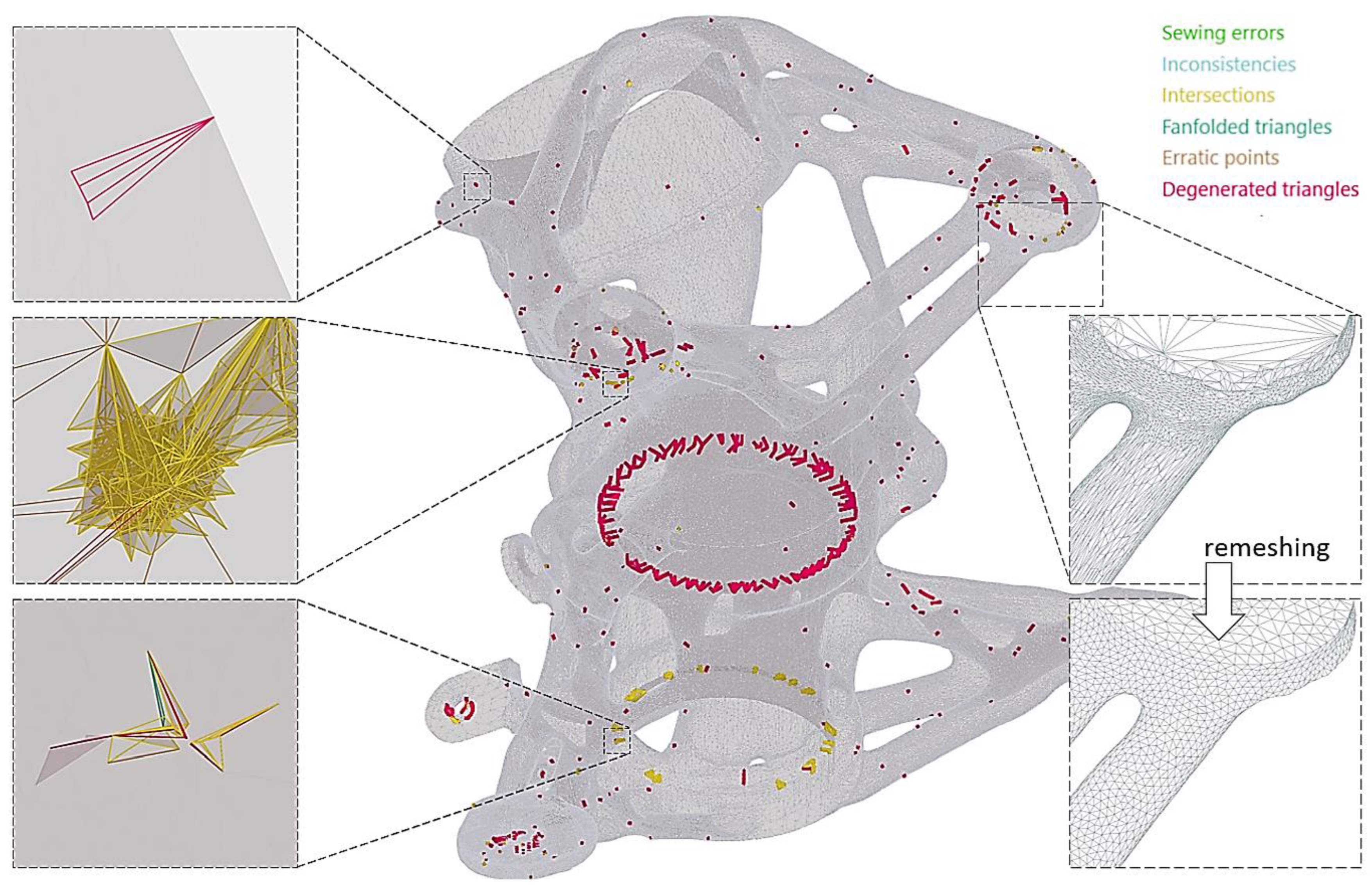

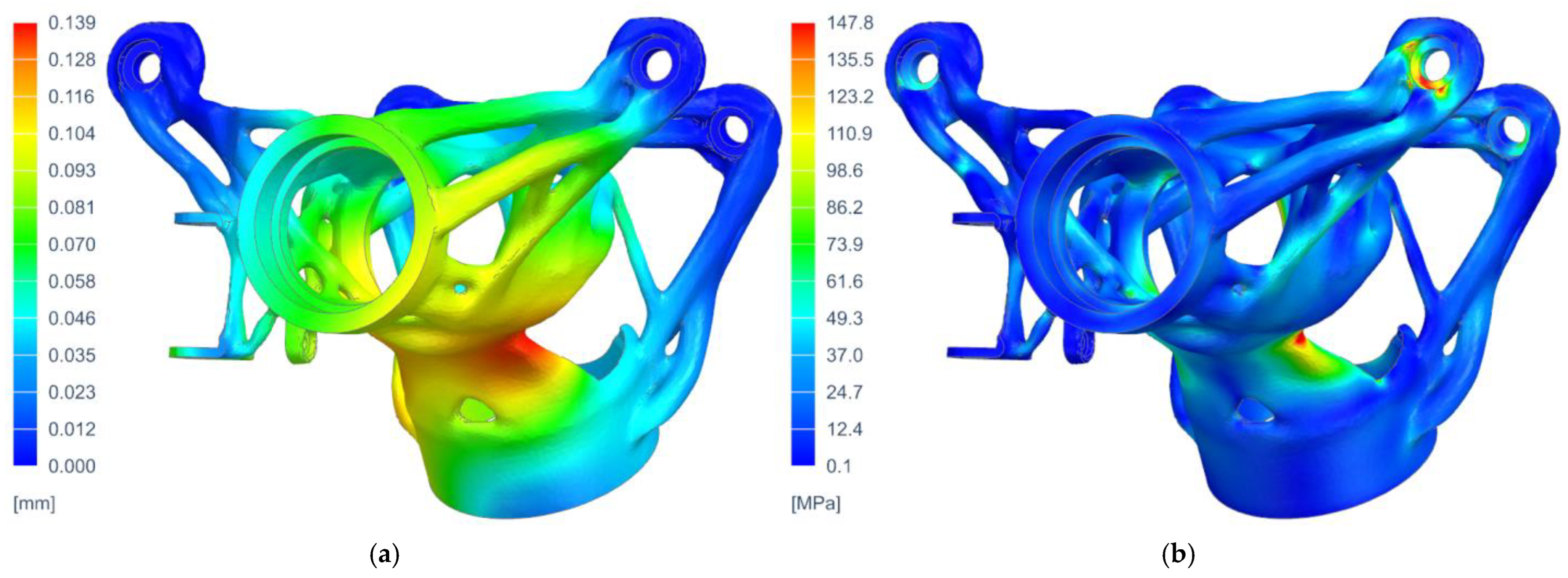
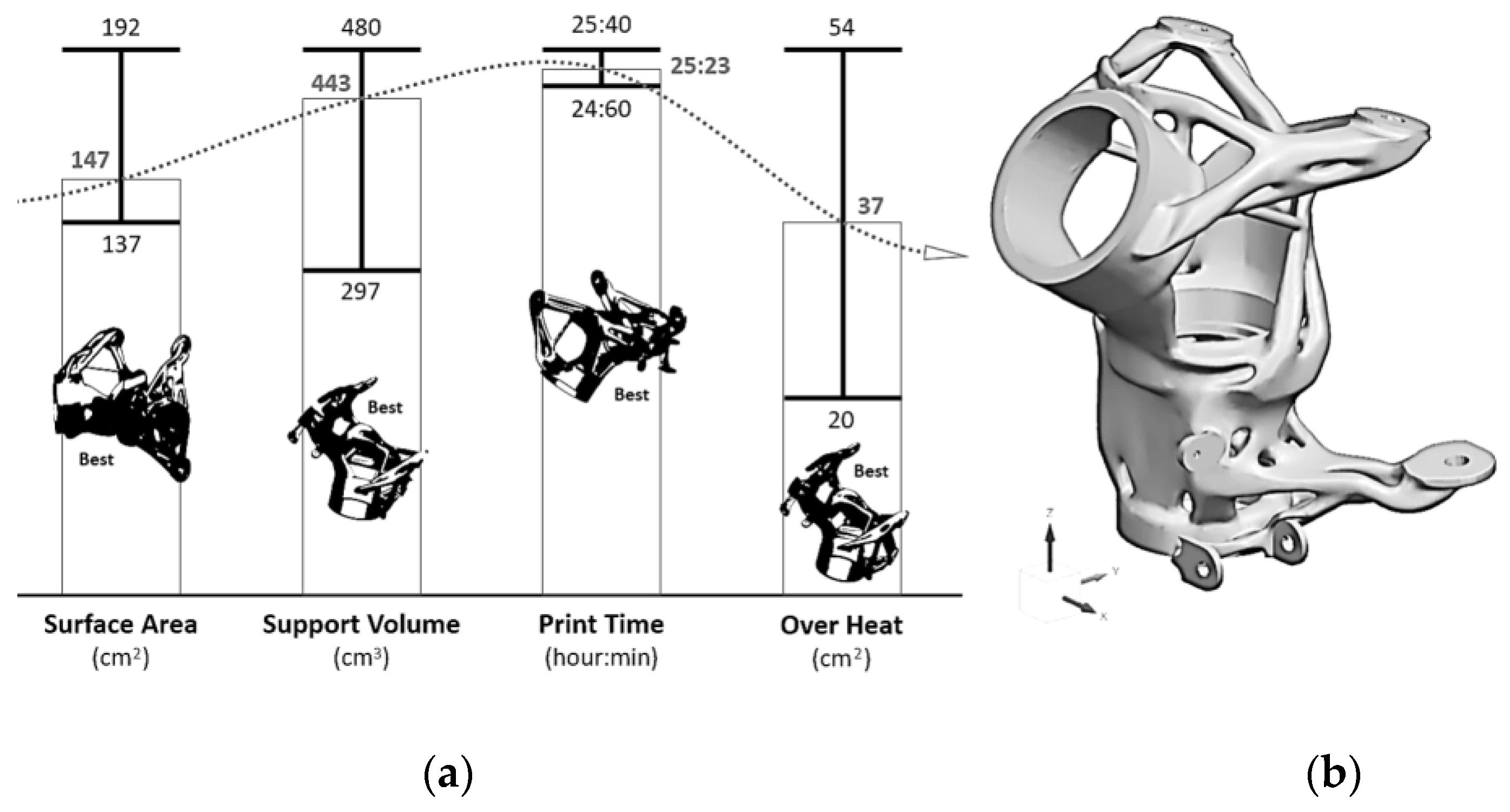

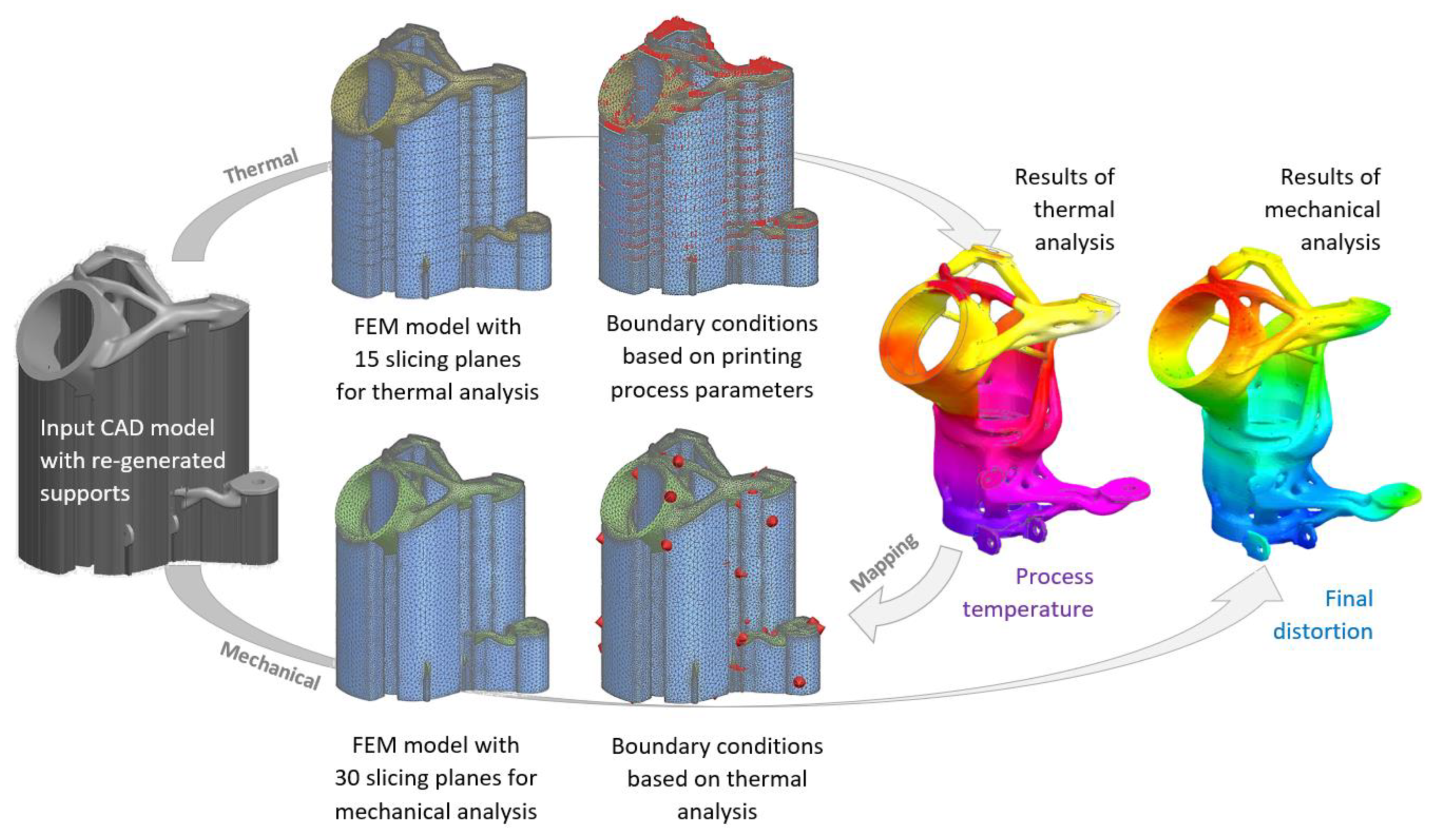
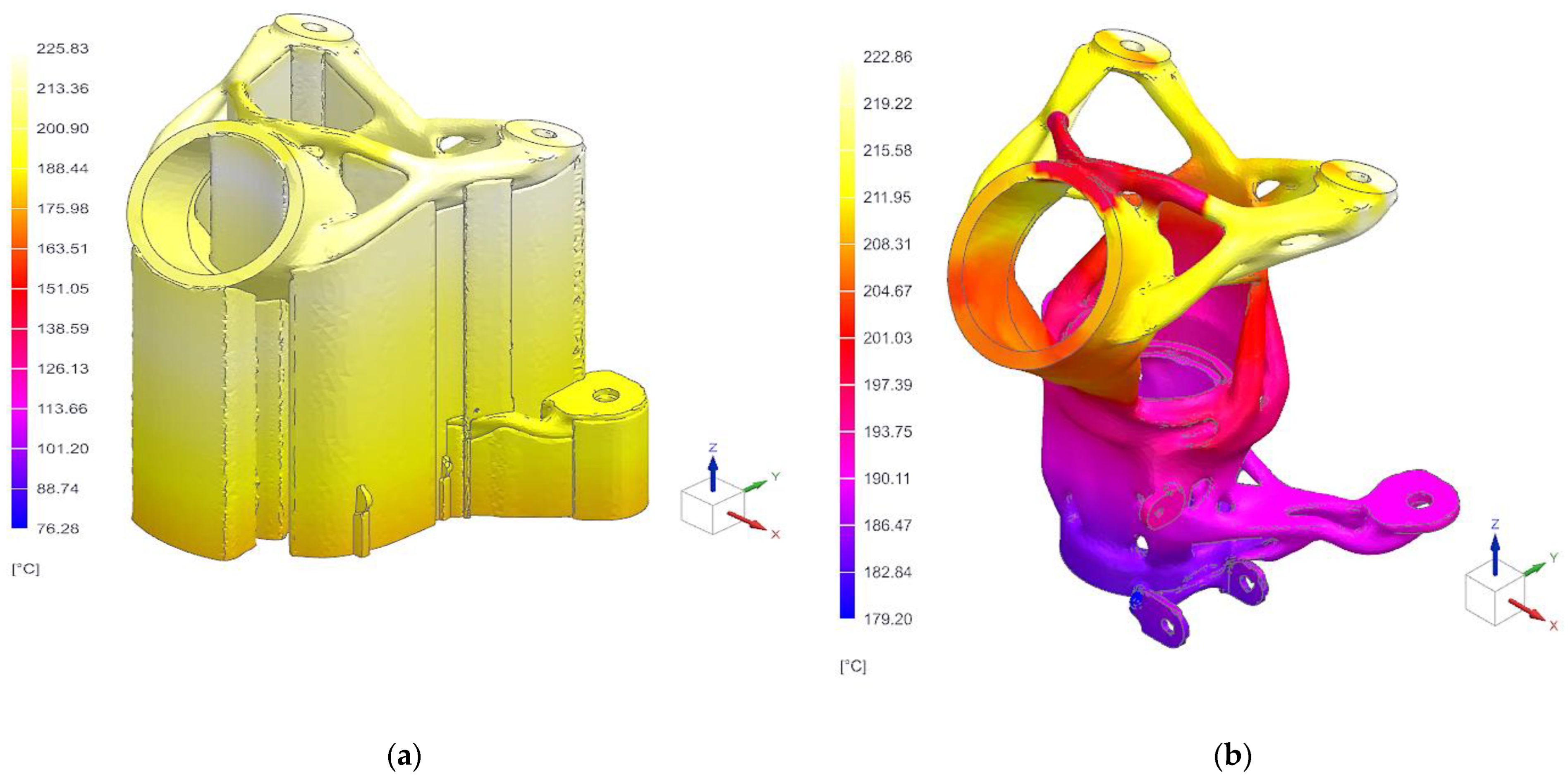
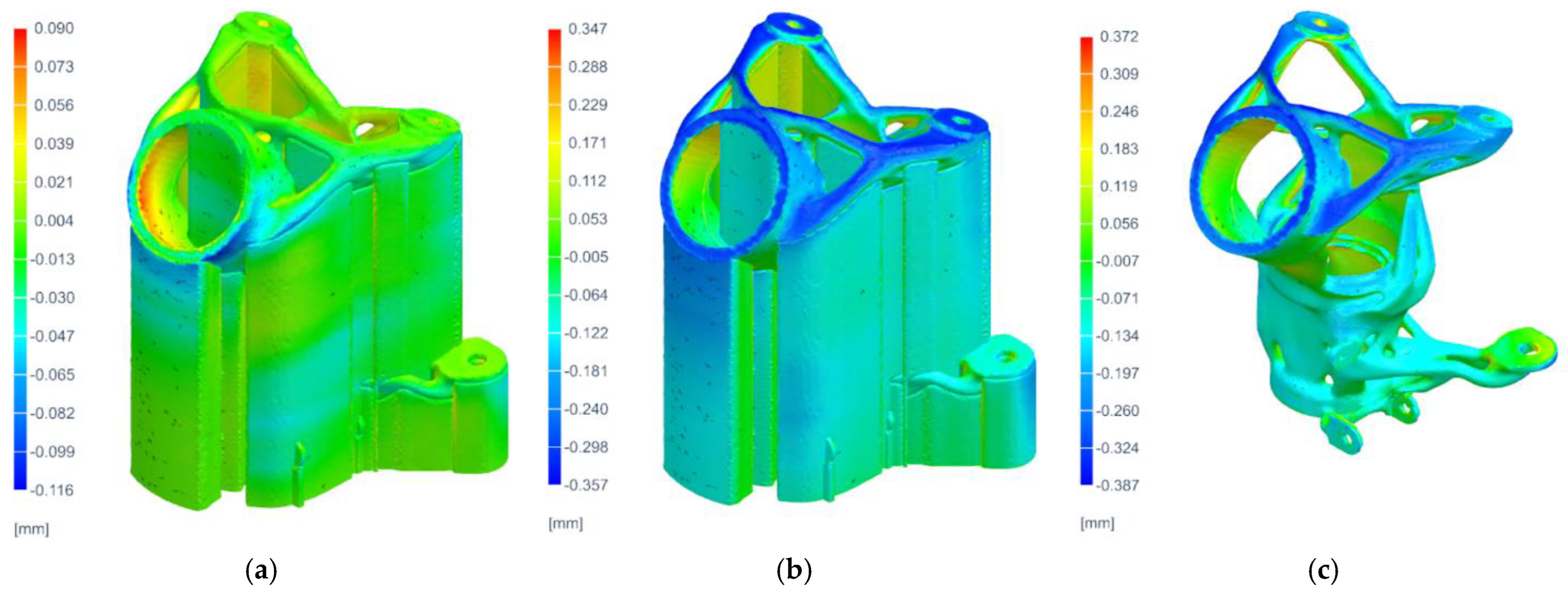
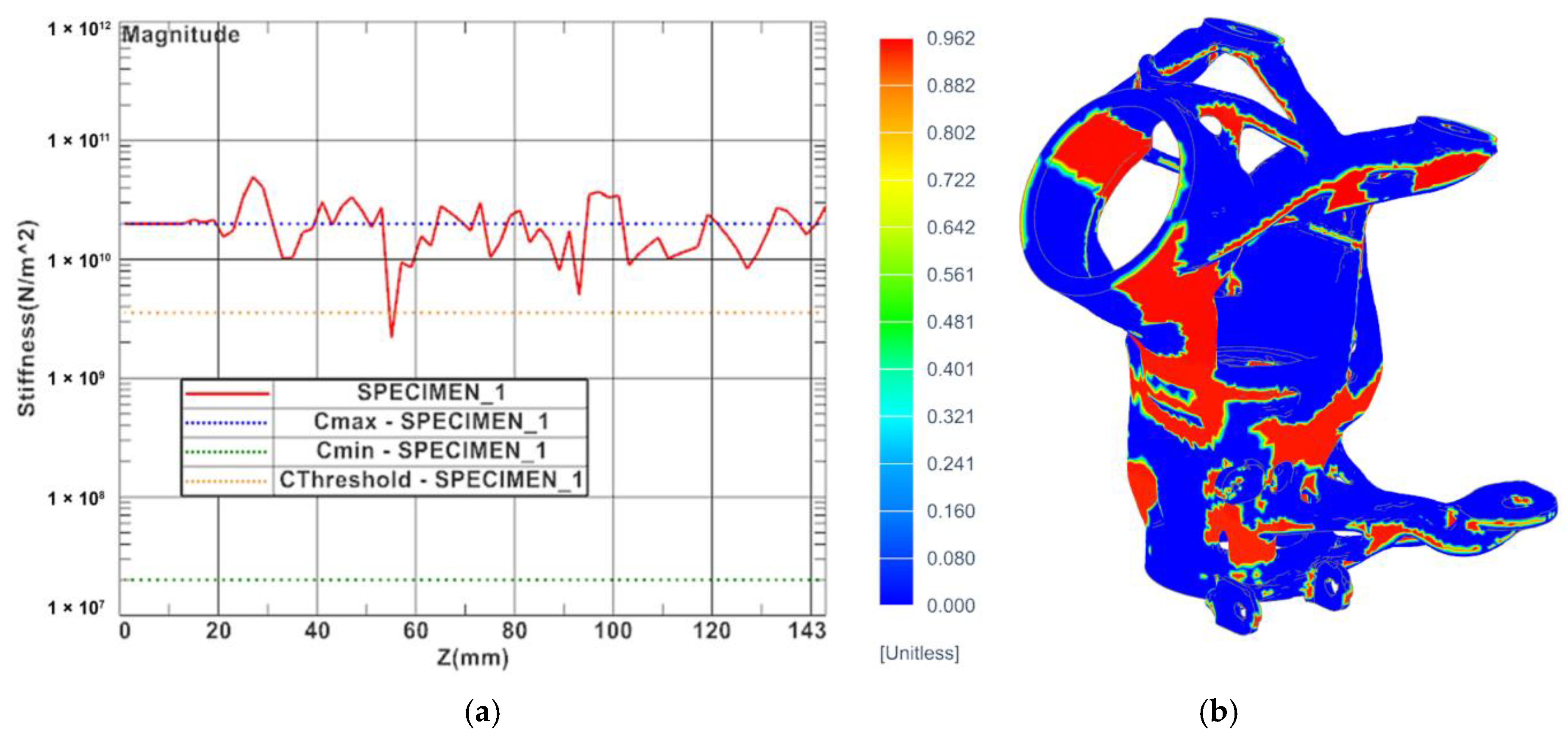
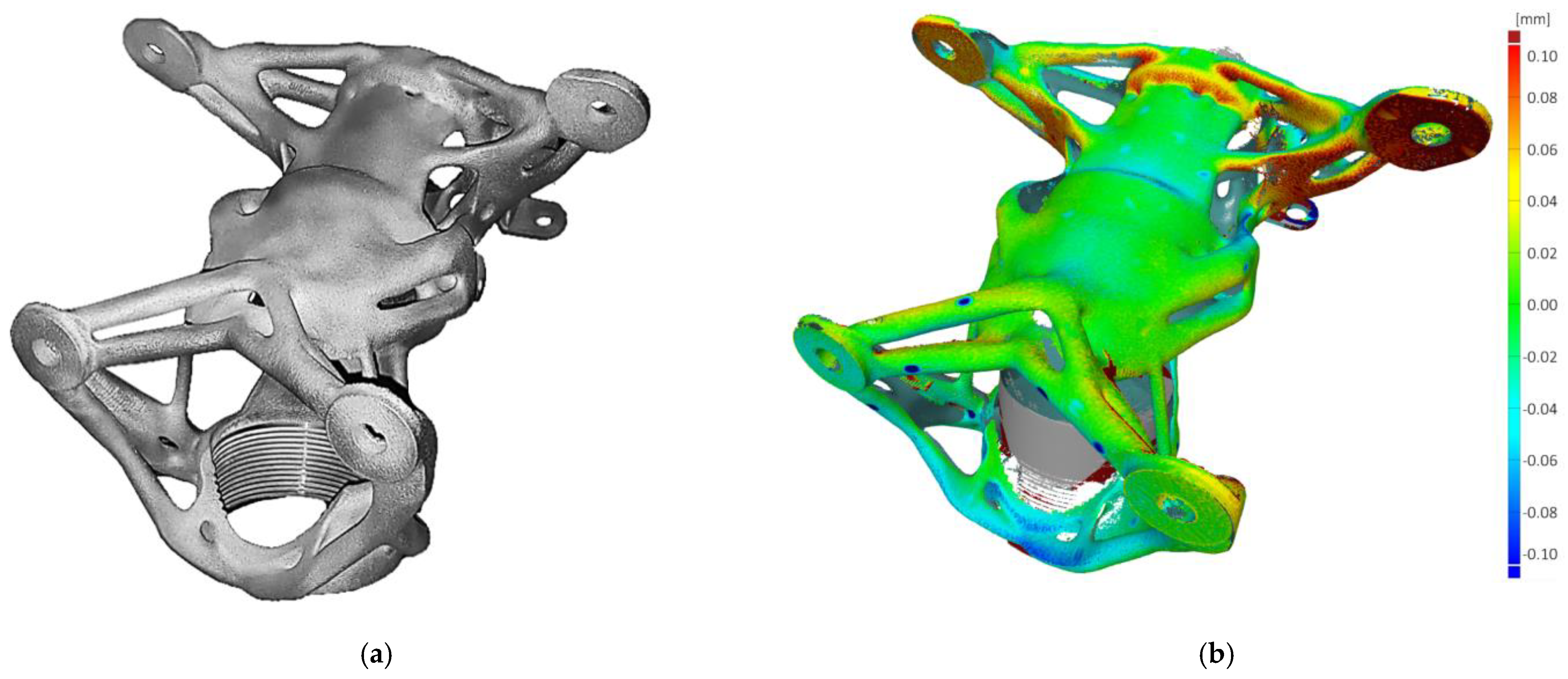

| Al | Si | Mg | Fe | Ti | Cu | Mn | Zn |
|---|---|---|---|---|---|---|---|
| Balanced | 9.9 | 0.43 | 0.24 | <0.01 | <0.005 | <0.005 | <0.002 |
| Power (W) | Scan Rate (mm/s) | Layer Thickness (µm) | Hatch Distance (µm) | Platform Temperature (°C) |
|---|---|---|---|---|
| 370 | 1150 | 30 | 100 | 150 |
| Parameter | Print Direction | Description | |
|---|---|---|---|
| VPS | HPS | ||
| (kg/m3) | 2670 | Density | |
| E (MPa) | 70 | 69 | Modulus of elasticity |
| ν (-) | 0.29 | Poisson’s ratio | |
| Rp0.2% (MPa) | 192 | 224 | Yield strength |
| (MPa) | 468 | 471 | Tensile strength |
| (%) | 9 ± 2 | 11 ± 2 | Elongation at break |
| Parameter | Value | Description |
|---|---|---|
| tR (s) | 12.25 | Recoating time |
| TBP (°C) | 147 | Base-plate temperature |
| TA (°C) | 46.85 | Ambient temperature |
| hHTC (W/(m.K)) | 20 | Ambient Gas HT |
| αBP (°C−1) | 1.20e−05 | Build plate/printer alpha |
| nPL | 1 | Number of lasers of printer |
Disclaimer/Publisher’s Note: The statements, opinions and data contained in all publications are solely those of the individual author(s) and contributor(s) and not of MDPI and/or the editor(s). MDPI and/or the editor(s) disclaim responsibility for any injury to people or property resulting from any ideas, methods, instructions or products referred to in the content. |
© 2023 by the authors. Licensee MDPI, Basel, Switzerland. This article is an open access article distributed under the terms and conditions of the Creative Commons Attribution (CC BY) license (https://creativecommons.org/licenses/by/4.0/).
Share and Cite
Sedlacek, F.; Kalina, T.; Stepanek, M. Optimization of Components with Topology Optimization for Direct Additive Manufacturing by DLMS. Materials 2023, 16, 5422. https://doi.org/10.3390/ma16155422
Sedlacek F, Kalina T, Stepanek M. Optimization of Components with Topology Optimization for Direct Additive Manufacturing by DLMS. Materials. 2023; 16(15):5422. https://doi.org/10.3390/ma16155422
Chicago/Turabian StyleSedlacek, Frantisek, Tomas Kalina, and Martin Stepanek. 2023. "Optimization of Components with Topology Optimization for Direct Additive Manufacturing by DLMS" Materials 16, no. 15: 5422. https://doi.org/10.3390/ma16155422
APA StyleSedlacek, F., Kalina, T., & Stepanek, M. (2023). Optimization of Components with Topology Optimization for Direct Additive Manufacturing by DLMS. Materials, 16(15), 5422. https://doi.org/10.3390/ma16155422







